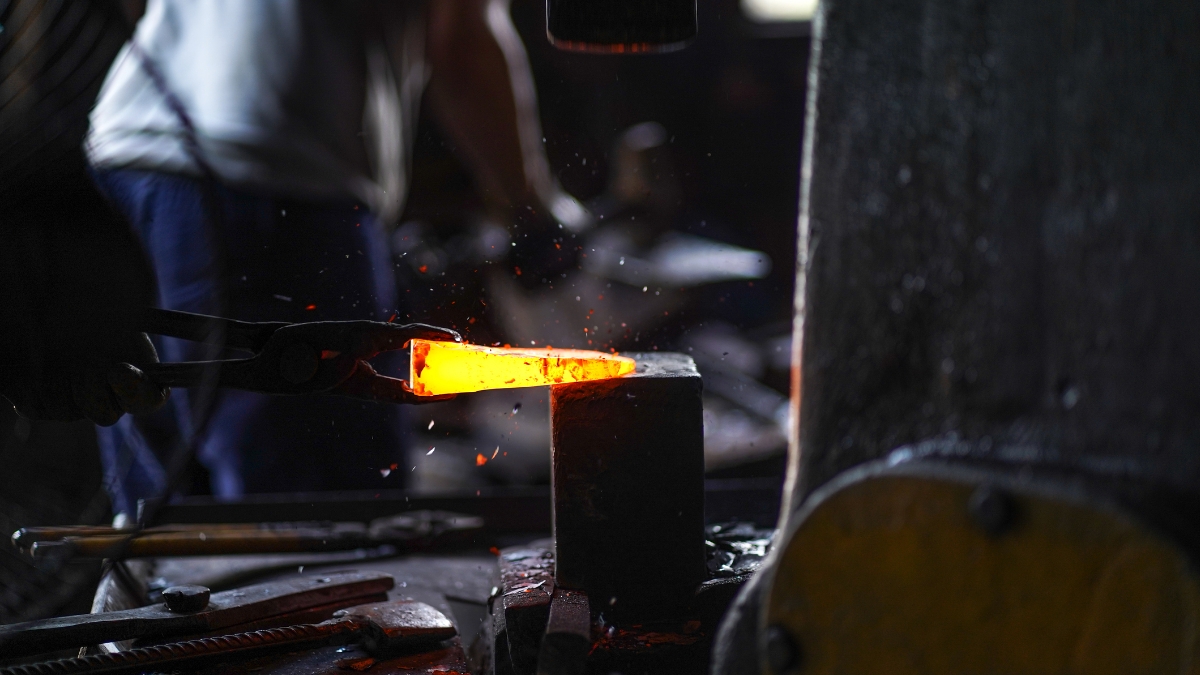Understanding the different forging processes
At its most basic level, forging is the process of forming and shaping metals through the use of hammering, pressing or rolling. The process begins with starting stock, typically a cast ingot which is heated to its plastic deformation temperature, then upset or “kneaded” between dies to the desired shape and size.
Here at CanForge, we utilize a variety of different forging techniques, each of which carries its own benefits. Generally, though, there are four recognized forging processes: closed-die forging, also known as impression-die forging, open-die forging, cold forging, and seamless rolled ring forging.
Today’s blog provides an overview of each, outlining what they entail, their benefits, and their common applications. 
Open-Die Forging
In open-die forging, a hammer strikes and deforms the raw material, which is placed on a stationary anvil.
What makes this process unique, is the fact that the dies (the surfaces in contact with the workpiece) don’t enclose the workpiece, allowing it to flow freely except for where it’s contacted by the dies. Therefore, it takes a skilled operator to orient and position the workpiece to create the desired shape.
Since the dies don’t completely enclose the base material, open-die forging is able to manufacture large and heavy components.
The railway and aircraft industries often make use of this process to manufacture components like cylinders, rollers, and shafts.
Advantages of Open-Die Forging
- Reduced chance of voids
- Better fatigue resistance
- Improved microstructure
- Continuous grain flow
- Finer grain size
- Greater strength
Seamless Rolled Ring Forging
Seamless rolled ring forging begins with a circular preform of metal that has been previously upset and pierced (using the open die forging process) to form a hollow “doughnut”. This doughnut is then heated above the re-crystallization temperature and placed over the idler or mandrel roll.
The idler roll then moves under pressure toward a drive roll that continuously rotates to reduce the wall thickness, thereby increasing the diameters of the resulting ring.
The high durability of rings manufactured from this forging process allows them to be used in heavy mining equipment, aerospace engines, wind power generators and railway equipment.
Advantages of Rolled Ring Forging
- Controlled directional grain flow
- Increased strength and superior structural integrity
- Minimized waste
- Elimination of inclusions and gas porosity
Closed Die Forging
Closed die forging, also known as impression-die forging, is the process in which two or more dies (called tooling) move towards each other to cover the heated raw material completely or partially.
The desired shape of the forging is incorporated in either the top or bottom die as a negative image. Then coming from above, the impact from the top die forms the raw material into the required forged form.
The automotive, mining, and oil and gas industries rely on this process to produce parts for fittings, flanges, and engine components.
Advantages of Closed-die forging
- Ability to reproduce nearly any shape and/or size
- More precise and consistent impressions
- Can achieve a variety of shapes and dimensions have tight tolerances
- Superior mechanical properties and better surface finish
Cold Forging
Unlike the above techniques, cold forging occurs below the metal’s recrystallization point – usually at or near room temperature. The raw material is placed between two dies where it is then squeezed until it has assumed its shape. This process is especially beneficial when using metals that are already soft, like aluminum.
Cold forgings are frequently used in the automotive industry to manufacture components with unusual or complex geometrics, like steering and suspension components, braking components, axles, clutches, gears, and pinions.
Advantages of cold forging
- Handles high stress and high die loads
- Produces net shape or near-net shape parts
- Good surface finish quality without the need for heat treatment or more costly materials
No matter the process, CanForge has your forging needs covered
Regardless of the process your project requires, CanForge has your forging needs covered! In fact, Canada Forgings Inc. is one of the few companies in North America to supply all sections of the forging market.
Contact us today to learn more about what we can do for you, or simply request a quote using our streamlined online form here.
